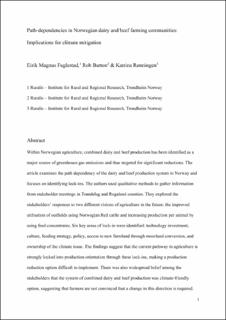| dc.description.abstract | Within Norwegian agriculture, combined dairy and beef production has been identified as a major source of greenhouse gas emissions and thus targeted for significant reductions. The article examines the path dependency of the dairy and beef production system in Norway and focuses on identifying lock-ins. The authors used qualitative methods to gather information from stakeholder meetings in Trøndelag and Rogaland counties. They explored the stakeholders’ responses to two different visions of agriculture in the future: the improved utilisation of outfields using Norwegian Red cattle and increasing production per animal by using feed concentrates. Six key areas of lock-in were identified: technology investment, culture, feeding strategy, policy, access to new farmland through moorland conversion, and ownership of the climate issue. The findings suggest that the current pathway in agriculture is strongly locked into production orientation through these lock-ins, making a production reduction option difficult to implement. There was also widespread belief among the stakeholders that the system of combined dairy and beef production was a climate-friendly option, suggesting that farmers are not convinced that a change in this direction is required. The authors conclude that the option of reducing production would be difficult to implement without addressing the multiple lock-in effects. | en_US |
